THINK champagne and you think flamboyance, elan and celebrations. Think food and you think happiness, fulfilment and celebrations. Pair the two and you have a flamboyant celebration with a touch of class and panache! That�s what I have been doing every night since January 2002, at the Chateau de Saran, a Moet & Chandon property, where I create new tastes with the innovative pairings of champagne and the finest foods. When champagne and food are equal, a synergy is created. I believe if you want to sample a strong-flavoured fish with, say, a plate of mixed salad or a farm-raised Chicken Rossini, sip on a Moet & Chandon Brut Imperial!
 The Chateau de Saran is a 12-room private house. I receive guests from all over the world here. They are invited for the night. Chefs, sommeliers, restaurateurs, journalists, movie stars, royalty... we get all sorts of people. And they are all invited, no bookings are taken at the Chateau de Saran, you cannot get in for love or money if you are not invited. It�s a traditional and exciting place. And very exclusive, too. Guests come to the cellar and at night, have their dinner with champagne. It is an exclusive dinner for 24. At Moet & Chandon, we approach wine and food pairings with no preconceptions. Sometimes the most unusual associations prove to be the most extraordinary.
The Chateau de Saran is a 12-room private house. I receive guests from all over the world here. They are invited for the night. Chefs, sommeliers, restaurateurs, journalists, movie stars, royalty... we get all sorts of people. And they are all invited, no bookings are taken at the Chateau de Saran, you cannot get in for love or money if you are not invited. It�s a traditional and exciting place. And very exclusive, too. Guests come to the cellar and at night, have their dinner with champagne. It is an exclusive dinner for 24. At Moet & Chandon, we approach wine and food pairings with no preconceptions. Sometimes the most unusual associations prove to be the most extraordinary.
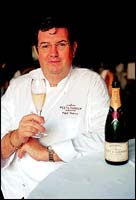 I�m extremely busy at the Chateau de Saran between March and October, that�s considered the season there, and after that I travel to different countries promoting Moet & Chandon champagne with various cuisines. I was in Japan last and San Francisco before that. From India I go to Belgium. It�s always the same event, but for me, it�s challenging. I meet different chefs and learn their cuisines from them. For instance, in Bombay I matched Moet & Chandon�s Brut Imperial Rose with spicy Indian curries at the Kandahar restaurant. By matching champagne with food, I learn about new cuisines. I fine-tune my culinary knowledge on different palates by creating a beautiful symphony with the champagnes from the Moet stables.
I�m extremely busy at the Chateau de Saran between March and October, that�s considered the season there, and after that I travel to different countries promoting Moet & Chandon champagne with various cuisines. I was in Japan last and San Francisco before that. From India I go to Belgium. It�s always the same event, but for me, it�s challenging. I meet different chefs and learn their cuisines from them. For instance, in Bombay I matched Moet & Chandon�s Brut Imperial Rose with spicy Indian curries at the Kandahar restaurant. By matching champagne with food, I learn about new cuisines. I fine-tune my culinary knowledge on different palates by creating a beautiful symphony with the champagnes from the Moet stables.
 The kind of cooking I do at the Chateau de Saran is specific to the champagnes and is a big challenge to me. Most of the recipes on my menus are based on traditional French cooking while others are enriched and inspired by world cuisines. But this is not fusion food. The recipes either preserve their traditional values or reveal their contemporary face. The idea is to show the champagne as a wine which is not meant to be drank just in celebration, but as an aperitif, and all during the meal. You can have a Moet & Chandon from appetiser to dessert. The food takes its inspiration from the champagne.
The kind of cooking I do at the Chateau de Saran is specific to the champagnes and is a big challenge to me. Most of the recipes on my menus are based on traditional French cooking while others are enriched and inspired by world cuisines. But this is not fusion food. The recipes either preserve their traditional values or reveal their contemporary face. The idea is to show the champagne as a wine which is not meant to be drank just in celebration, but as an aperitif, and all during the meal. You can have a Moet & Chandon from appetiser to dessert. The food takes its inspiration from the champagne.
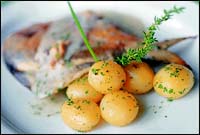 I have to find a balance between the bitterness, saltiness, acidity and sweetness of food, and champagne. You take a wine, it has the same characteristics as food except for the saltiness. And there has to be a balance between the acidity and sugar of the food also. If the food is too acidic, the champagne tastes too sweet. And if the food is too sweet, the champagne tastes acidic! It�s strange, but there has to be bitterness and saltiness in food to boost the taste of the champagne. Say you are having a dish of scallops or prawns. Consume them by dipping the food in salt, lime and soy sauce, and each time you will get different aromas and flavours in the champagne!
I have to find a balance between the bitterness, saltiness, acidity and sweetness of food, and champagne. You take a wine, it has the same characteristics as food except for the saltiness. And there has to be a balance between the acidity and sugar of the food also. If the food is too acidic, the champagne tastes too sweet. And if the food is too sweet, the champagne tastes acidic! It�s strange, but there has to be bitterness and saltiness in food to boost the taste of the champagne. Say you are having a dish of scallops or prawns. Consume them by dipping the food in salt, lime and soy sauce, and each time you will get different aromas and flavours in the champagne!
 Champagne goes well with cheese, lobster, fish and chicken. Actually you can match it with any kind of food, except anything vinegary. Vinegar is a wine killer. Not balsamic vinegar, though, because balsamic is not a vinegar it�s a wine! I�m often asked if I cook with champagne, but I don�t really. I only do a Red-fruit Terrine with champagne. You cannot cook the wine and retain its flavour. It gets lost. The trick is just to warm it to release the flavour of the wine. If you boil it, you not only lose the alcohol content, but also the aromas. You know the classic way to clarify a Lobster Consomme is by cooking caviar in it. What a waste of a good product! Likewise, I prefer to drink the champagne than use it to make a sauce.
Champagne goes well with cheese, lobster, fish and chicken. Actually you can match it with any kind of food, except anything vinegary. Vinegar is a wine killer. Not balsamic vinegar, though, because balsamic is not a vinegar it�s a wine! I�m often asked if I cook with champagne, but I don�t really. I only do a Red-fruit Terrine with champagne. You cannot cook the wine and retain its flavour. It gets lost. The trick is just to warm it to release the flavour of the wine. If you boil it, you not only lose the alcohol content, but also the aromas. You know the classic way to clarify a Lobster Consomme is by cooking caviar in it. What a waste of a good product! Likewise, I prefer to drink the champagne than use it to make a sauce.
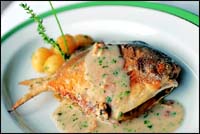 I, of course, love Moet & Chandon champagne. I am tasting it all the time. I work a lot with the wine-makers at Moet & Chandon. It�s funny, but when I am drinking champagne, I like to wait and smell the glass and to talk to friends while I appreciate the champagne. What kind of food do I enjoy best with champagne? Fortunately, it is not French! Champagne is very open to being matched with a lot of cuisines. It goes excellently with Japanese sushi, the mix of sweetness in the rice, the bitterness in the wasabi, and the saltiness in the fish is the kind of balance in food that boosts the flavour of champagne and releases its flavours. The texture and crispiness of the food also matters to the champagne. Always try to have a crispy and smooth balance � like a brioche on the side if not in the plate.
I, of course, love Moet & Chandon champagne. I am tasting it all the time. I work a lot with the wine-makers at Moet & Chandon. It�s funny, but when I am drinking champagne, I like to wait and smell the glass and to talk to friends while I appreciate the champagne. What kind of food do I enjoy best with champagne? Fortunately, it is not French! Champagne is very open to being matched with a lot of cuisines. It goes excellently with Japanese sushi, the mix of sweetness in the rice, the bitterness in the wasabi, and the saltiness in the fish is the kind of balance in food that boosts the flavour of champagne and releases its flavours. The texture and crispiness of the food also matters to the champagne. Always try to have a crispy and smooth balance � like a brioche on the side if not in the plate.
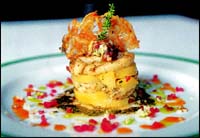 Indian cuisines go marvellously well with Moet & Chandon�s champagnes. I love your curries. I think the Mango Salsa matches well. The Coriander Prawns too, because of the sharpness of the coriander flavour and the texture of the prawns. The Brut Imperial Rose goes well with Chicken Curry. It is so very important that the champagne be served at the right temperature. If the food is going to be warm and the champagne cold, then your mouth gets anaestheticised with the first bite and you don�t smell any of the flavours. Keep the champagne between 8 and 10 degrees C. Serve it at 8 degrees. In 10 minutes, it become 12 degrees C. Remember the food is meant to be behind the wine. And that there should not be too many different tastes in the plate. The food is meant to show the different characteristics of the champagne and is not meant to be complicated.
Indian cuisines go marvellously well with Moet & Chandon�s champagnes. I love your curries. I think the Mango Salsa matches well. The Coriander Prawns too, because of the sharpness of the coriander flavour and the texture of the prawns. The Brut Imperial Rose goes well with Chicken Curry. It is so very important that the champagne be served at the right temperature. If the food is going to be warm and the champagne cold, then your mouth gets anaestheticised with the first bite and you don�t smell any of the flavours. Keep the champagne between 8 and 10 degrees C. Serve it at 8 degrees. In 10 minutes, it become 12 degrees C. Remember the food is meant to be behind the wine. And that there should not be too many different tastes in the plate. The food is meant to show the different characteristics of the champagne and is not meant to be complicated.
 When I travel, I don�t really cook in foreign styles, because there are so many traditions in cuisines that I would never be as good as the local chefs. But I adapt. I prefer to learn from them. And I pick up the measurements of different tastes. I�m always willing to be open. So much of a cuisine depends on the culture of the country it is from. I learnt simplicity from the Japanese, from the Chinese I learnt how to cook quickly, and French cooking is simpler and quicker... a bit like Italian cooking. I tell foreign chefs when I travel to be simple in their methods. I�m not there to cook or learn how to cook. I�m there to show the champagne. The star is always the champagne. It is important to be behind it all the time.
When I travel, I don�t really cook in foreign styles, because there are so many traditions in cuisines that I would never be as good as the local chefs. But I adapt. I prefer to learn from them. And I pick up the measurements of different tastes. I�m always willing to be open. So much of a cuisine depends on the culture of the country it is from. I learnt simplicity from the Japanese, from the Chinese I learnt how to cook quickly, and French cooking is simpler and quicker... a bit like Italian cooking. I tell foreign chefs when I travel to be simple in their methods. I�m not there to cook or learn how to cook. I�m there to show the champagne. The star is always the champagne. It is important to be behind it all the time.
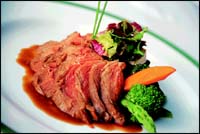 My menus at the Chateau de Saran change all the time. With me, it is a question of what produce is available in the market. I select the best and use it rightaway. I�m lucky to be a chef with Moet & Chandon, I don�t have to worry about anything, not about reservations for dinner or the prices. I just have to do my best by way of the dinners every night. I have two other chefs, and one pastry chef, in the kitchen with me. And three men for service. With Moet & Chandon champagne as the perfect companion and the Chateau de Saran playing host, it�s not the mathematics of the table of 24 that makes the pleasure, but the magic. My guests savour the magical synergy of the culinary traditions I produce with the world class champagne that has been developed and perfected over centuries and which makes French cooking a highly refined art.
My menus at the Chateau de Saran change all the time. With me, it is a question of what produce is available in the market. I select the best and use it rightaway. I�m lucky to be a chef with Moet & Chandon, I don�t have to worry about anything, not about reservations for dinner or the prices. I just have to do my best by way of the dinners every night. I have two other chefs, and one pastry chef, in the kitchen with me. And three men for service. With Moet & Chandon champagne as the perfect companion and the Chateau de Saran playing host, it�s not the mathematics of the table of 24 that makes the pleasure, but the magic. My guests savour the magical synergy of the culinary traditions I produce with the world class champagne that has been developed and perfected over centuries and which makes French cooking a highly refined art.



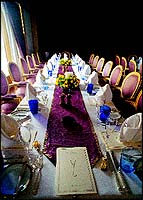 The Flavours Of Champagne!
The Flavours Of Champagne!

 The Chateau de Saran is a 12-room private house. I receive guests from all over the world here. They are invited for the night. Chefs, sommeliers, restaurateurs, journalists, movie stars, royalty... we get all sorts of people. And they are all invited, no bookings are taken at the Chateau de Saran, you cannot get in for love or money if you are not invited. It�s a traditional and exciting place. And very exclusive, too. Guests come to the cellar and at night, have their dinner with champagne. It is an exclusive dinner for 24. At Moet & Chandon, we approach wine and food pairings with no preconceptions. Sometimes the most unusual associations prove to be the most extraordinary.
The Chateau de Saran is a 12-room private house. I receive guests from all over the world here. They are invited for the night. Chefs, sommeliers, restaurateurs, journalists, movie stars, royalty... we get all sorts of people. And they are all invited, no bookings are taken at the Chateau de Saran, you cannot get in for love or money if you are not invited. It�s a traditional and exciting place. And very exclusive, too. Guests come to the cellar and at night, have their dinner with champagne. It is an exclusive dinner for 24. At Moet & Chandon, we approach wine and food pairings with no preconceptions. Sometimes the most unusual associations prove to be the most extraordinary. I�m extremely busy at the Chateau de Saran between March and October, that�s considered the season there, and after that I travel to different countries promoting Moet & Chandon champagne with various cuisines. I was in Japan last and San Francisco before that. From India I go to Belgium. It�s always the same event, but for me, it�s challenging. I meet different chefs and learn their cuisines from them. For instance, in Bombay I matched Moet & Chandon�s Brut Imperial Rose with spicy Indian curries at the Kandahar restaurant. By matching champagne with food, I learn about new cuisines. I fine-tune my culinary knowledge on different palates by creating a beautiful symphony with the champagnes from the Moet stables.
I�m extremely busy at the Chateau de Saran between March and October, that�s considered the season there, and after that I travel to different countries promoting Moet & Chandon champagne with various cuisines. I was in Japan last and San Francisco before that. From India I go to Belgium. It�s always the same event, but for me, it�s challenging. I meet different chefs and learn their cuisines from them. For instance, in Bombay I matched Moet & Chandon�s Brut Imperial Rose with spicy Indian curries at the Kandahar restaurant. By matching champagne with food, I learn about new cuisines. I fine-tune my culinary knowledge on different palates by creating a beautiful symphony with the champagnes from the Moet stables. The kind of cooking I do at the Chateau de Saran is specific to the champagnes and is a big challenge to me. Most of the recipes on my menus are based on traditional French cooking while others are enriched and inspired by world cuisines. But this is not fusion food. The recipes either preserve their traditional values or reveal their contemporary face. The idea is to show the champagne as a wine which is not meant to be drank just in celebration, but as an aperitif, and all during the meal. You can have a Moet & Chandon from appetiser to dessert. The food takes its inspiration from the champagne.
The kind of cooking I do at the Chateau de Saran is specific to the champagnes and is a big challenge to me. Most of the recipes on my menus are based on traditional French cooking while others are enriched and inspired by world cuisines. But this is not fusion food. The recipes either preserve their traditional values or reveal their contemporary face. The idea is to show the champagne as a wine which is not meant to be drank just in celebration, but as an aperitif, and all during the meal. You can have a Moet & Chandon from appetiser to dessert. The food takes its inspiration from the champagne. I have to find a balance between the bitterness, saltiness, acidity and sweetness of food, and champagne. You take a wine, it has the same characteristics as food except for the saltiness. And there has to be a balance between the acidity and sugar of the food also. If the food is too acidic, the champagne tastes too sweet. And if the food is too sweet, the champagne tastes acidic! It�s strange, but there has to be bitterness and saltiness in food to boost the taste of the champagne. Say you are having a dish of scallops or prawns. Consume them by dipping the food in salt, lime and soy sauce, and each time you will get different aromas and flavours in the champagne!
I have to find a balance between the bitterness, saltiness, acidity and sweetness of food, and champagne. You take a wine, it has the same characteristics as food except for the saltiness. And there has to be a balance between the acidity and sugar of the food also. If the food is too acidic, the champagne tastes too sweet. And if the food is too sweet, the champagne tastes acidic! It�s strange, but there has to be bitterness and saltiness in food to boost the taste of the champagne. Say you are having a dish of scallops or prawns. Consume them by dipping the food in salt, lime and soy sauce, and each time you will get different aromas and flavours in the champagne! Champagne goes well with cheese, lobster, fish and chicken. Actually you can match it with any kind of food, except anything vinegary. Vinegar is a wine killer. Not balsamic vinegar, though, because balsamic is not a vinegar it�s a wine! I�m often asked if I cook with champagne, but I don�t really. I only do a Red-fruit Terrine with champagne. You cannot cook the wine and retain its flavour. It gets lost. The trick is just to warm it to release the flavour of the wine. If you boil it, you not only lose the alcohol content, but also the aromas. You know the classic way to clarify a Lobster Consomme is by cooking caviar in it. What a waste of a good product! Likewise, I prefer to drink the champagne than use it to make a sauce.
Champagne goes well with cheese, lobster, fish and chicken. Actually you can match it with any kind of food, except anything vinegary. Vinegar is a wine killer. Not balsamic vinegar, though, because balsamic is not a vinegar it�s a wine! I�m often asked if I cook with champagne, but I don�t really. I only do a Red-fruit Terrine with champagne. You cannot cook the wine and retain its flavour. It gets lost. The trick is just to warm it to release the flavour of the wine. If you boil it, you not only lose the alcohol content, but also the aromas. You know the classic way to clarify a Lobster Consomme is by cooking caviar in it. What a waste of a good product! Likewise, I prefer to drink the champagne than use it to make a sauce. I, of course, love Moet & Chandon champagne. I am tasting it all the time. I work a lot with the wine-makers at Moet & Chandon. It�s funny, but when I am drinking champagne, I like to wait and smell the glass and to talk to friends while I appreciate the champagne. What kind of food do I enjoy best with champagne? Fortunately, it is not French! Champagne is very open to being matched with a lot of cuisines. It goes excellently with Japanese sushi, the mix of sweetness in the rice, the bitterness in the wasabi, and the saltiness in the fish is the kind of balance in food that boosts the flavour of champagne and releases its flavours. The texture and crispiness of the food also matters to the champagne. Always try to have a crispy and smooth balance � like a brioche on the side if not in the plate.
I, of course, love Moet & Chandon champagne. I am tasting it all the time. I work a lot with the wine-makers at Moet & Chandon. It�s funny, but when I am drinking champagne, I like to wait and smell the glass and to talk to friends while I appreciate the champagne. What kind of food do I enjoy best with champagne? Fortunately, it is not French! Champagne is very open to being matched with a lot of cuisines. It goes excellently with Japanese sushi, the mix of sweetness in the rice, the bitterness in the wasabi, and the saltiness in the fish is the kind of balance in food that boosts the flavour of champagne and releases its flavours. The texture and crispiness of the food also matters to the champagne. Always try to have a crispy and smooth balance � like a brioche on the side if not in the plate. Indian cuisines go marvellously well with Moet & Chandon�s champagnes. I love your curries. I think the Mango Salsa matches well. The Coriander Prawns too, because of the sharpness of the coriander flavour and the texture of the prawns. The Brut Imperial Rose goes well with Chicken Curry. It is so very important that the champagne be served at the right temperature. If the food is going to be warm and the champagne cold, then your mouth gets anaestheticised with the first bite and you don�t smell any of the flavours. Keep the champagne between 8 and 10 degrees C. Serve it at 8 degrees. In 10 minutes, it become 12 degrees C. Remember the food is meant to be behind the wine. And that there should not be too many different tastes in the plate. The food is meant to show the different characteristics of the champagne and is not meant to be complicated.
Indian cuisines go marvellously well with Moet & Chandon�s champagnes. I love your curries. I think the Mango Salsa matches well. The Coriander Prawns too, because of the sharpness of the coriander flavour and the texture of the prawns. The Brut Imperial Rose goes well with Chicken Curry. It is so very important that the champagne be served at the right temperature. If the food is going to be warm and the champagne cold, then your mouth gets anaestheticised with the first bite and you don�t smell any of the flavours. Keep the champagne between 8 and 10 degrees C. Serve it at 8 degrees. In 10 minutes, it become 12 degrees C. Remember the food is meant to be behind the wine. And that there should not be too many different tastes in the plate. The food is meant to show the different characteristics of the champagne and is not meant to be complicated. When I travel, I don�t really cook in foreign styles, because there are so many traditions in cuisines that I would never be as good as the local chefs. But I adapt. I prefer to learn from them. And I pick up the measurements of different tastes. I�m always willing to be open. So much of a cuisine depends on the culture of the country it is from. I learnt simplicity from the Japanese, from the Chinese I learnt how to cook quickly, and French cooking is simpler and quicker... a bit like Italian cooking. I tell foreign chefs when I travel to be simple in their methods. I�m not there to cook or learn how to cook. I�m there to show the champagne. The star is always the champagne. It is important to be behind it all the time.
When I travel, I don�t really cook in foreign styles, because there are so many traditions in cuisines that I would never be as good as the local chefs. But I adapt. I prefer to learn from them. And I pick up the measurements of different tastes. I�m always willing to be open. So much of a cuisine depends on the culture of the country it is from. I learnt simplicity from the Japanese, from the Chinese I learnt how to cook quickly, and French cooking is simpler and quicker... a bit like Italian cooking. I tell foreign chefs when I travel to be simple in their methods. I�m not there to cook or learn how to cook. I�m there to show the champagne. The star is always the champagne. It is important to be behind it all the time. My menus at the Chateau de Saran change all the time. With me, it is a question of what produce is available in the market. I select the best and use it rightaway. I�m lucky to be a chef with Moet & Chandon, I don�t have to worry about anything, not about reservations for dinner or the prices. I just have to do my best by way of the dinners every night. I have two other chefs, and one pastry chef, in the kitchen with me. And three men for service. With Moet & Chandon champagne as the perfect companion and the Chateau de Saran playing host, it�s not the mathematics of the table of 24 that makes the pleasure, but the magic. My guests savour the magical synergy of the culinary traditions I produce with the world class champagne that has been developed and perfected over centuries and which makes French cooking a highly refined art.
My menus at the Chateau de Saran change all the time. With me, it is a question of what produce is available in the market. I select the best and use it rightaway. I�m lucky to be a chef with Moet & Chandon, I don�t have to worry about anything, not about reservations for dinner or the prices. I just have to do my best by way of the dinners every night. I have two other chefs, and one pastry chef, in the kitchen with me. And three men for service. With Moet & Chandon champagne as the perfect companion and the Chateau de Saran playing host, it�s not the mathematics of the table of 24 that makes the pleasure, but the magic. My guests savour the magical synergy of the culinary traditions I produce with the world class champagne that has been developed and perfected over centuries and which makes French cooking a highly refined art.